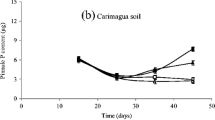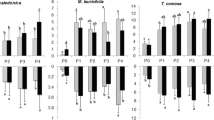Abstract
To examine the effects of microbial populations and external phosphorus supply of two Philippine soils on mycorrhizal formation, Eucalyptus urophylla seedlings were inoculated with two Pisolithus isolates and grown in fumigated, reinfested and unfumigated soil fertilized with four rates of phosphorus. The Pisolithus isolates used were collected from under eucalypts in Australia and in the Philippines. Soils were infertile acid silty loams collected from field sites in Pangasinan, Luzon and Surigao, Mindanao.
Significant interaction was observed between inoculation, soil fumigation and phosphorus supply on mycorrhizal formation by the Australian isolate in Surigao soil but not in Pangasinan soil. Soil fumigation enhanced mycorrhizal formation by the Australian isolate but did not affect root colonization by the Philippine isolate. Root colonization by the Australian isolate was highest in the reinfested soil while for the Philippine isolate it was highest in the unfumigated soil. The Australian isolate was more effective than the Philippine isolate in promoting growth and P uptake of E. urophylla seedlings in both soils. Total dry weight and P uptake of E. urophylla seedlings inoculated with the Australian isolate were maximum in fumigated and in the reinfested Pangasinan and Surigao soils supplied with 8 mg P kg-1 soil. In the unfumigated soil, growth of seedlings inoculated with the Australian isolate was significantly reduced. Seedlings inoculated with the Philippine isolate had the largest dry weights and P contents in unfumigated Pangasinan and Surigao soils supplied with 8 mg P kg-1 soil.
These results indicate that the performance of the Australian Pisolithus isolate was markedly affected by biological factors in unfumigated soil. Thus, its potential use in the Philippines needs to be thoroughly tested in a variety of unfumigated soils before its widespread use in any inoculation programme.
Similar content being viewed by others
References
An Z-Q, Hendrix J W, Hershman D E, Ferris R S and Henson G T 1993 The influence of crop rotation and soil fumigation on a mycorrhizal fungal community associated with soybean. Mycorrhiza 3, 171–182.
Black C A 1965 Methods of Soil Analysis, Part 2. Chemical and microbiological Properties. Am. Soc. Agron. Monogr. No. 9. Am. Soc. Agron., Madison, WI, USA.
Bougher N L, Grove T S and Malajczuk N 1990 Growth and phosphorus acquisition of karri (Eucalyptus diversicolor F. Muell.) seedlings inoculated with ectomycorrhizal fungi in relation to phosphorus supply. New Phytol. 114, 77–85.
Bowen G D 1987 The biology and physiology of infection and its development. In Ecophysiology of VA Mycorrhizal Plants. Ed. G R Safir. pp 27–57. CRC Press, Boca Raton, FL.
Bowen G D and Theodorou C 1979 Interactions between bacteria and ectomycorrhizal fungi. Soil Biol. Biochem. 11, 119–126.
Burgess T, Malajczuk N and Dell B 1994 Variation in mycorrhizal development and growth stimulation of 20 Pisolithus isolates inoculated onto Eucalyptus grandis W. Hill ex Maiden. New Phytol. 127, 731–739.
Burgess T, Malajczuk N and Grove T S 1993 The ability of 16 ectomycorrhizal fungi to increase the growth and phosphorus uptake of Eucalyptus globulus Labill and E. diversicolor F. Muell. Plant and Soil 153, 55–164.
De la Cruz R E, Aggangan N S, Zarate J T and Yecyec R P 1991 Improved reforestation technologies in the Philippines. PCARRD Book Series 121, 65–78.
De la Cruz R E, Lorilla E B and Aggangan N S 1990 Ectomycorrhizal tablets for Eucalyptus species. In Fast growing Trees and Nitrogen Fixing Trees. Eds. D Werner and P Muller. p 371. Gustav Fisher Verlag, Stuttgart, Germany.
Dell B, Malajczuk N and Grove T S 1995 Nutrient Disorders in Plantation Eucalypts. ACIAR Monogr. 31, 110.
Dewis J and Freitas F 1970 Physical and Chemical Methods of soil and water analysis. FAO, Soil Bulletin. No. 10. FAO, Rome, Italy.
Duncan D B 1955 Multiple range and multiple F tests. Biometrics 11, 1–24.
Fitter A H and Garbaye J 1994 Interactions between mycorrhizal fungi and other soil organisms. Plant and Soil 159, 123–132.
Garbaye J and Bowen G D 1987 Effect of different microflora on the success of ectomycorrhizal inoculation of Pinus radiata. Can. J. For. Res. 17, 941–943.
Garbaye J and Bowen G D 1989 Stimulation of ectomycorrhizal infection of Pinus radiata by some microorganisms associated with the mantle of ectomycorrhizas. New Phytol. 112, 383–386.
Garbaye J, Delwaulle J C and Diangana D 1988 Growth response of eucalypts in the Congo to ectomycorrhizal inoculation. For. Ecol. Manage. 24, 151–157.
Hardy G E St J and Sivasithamparam K 1985 Soil solarization: Effects on Fusarium wilt of carnation and Verticillium wilt of eggplant. In Ecology and Management of Soil-borne Plant Pathogens. Eds. C A Parker, A D Rovira K J Moore and P T W Wong. pp 279–281. Am. Phytopath. Soc., St. Paul, USA.
Jawson M D, Franzluebbers, Galusha D K and Aiken R M 1993 Soil fumigation within monoculture and rotations: Response of corn and mycorrhizae. Agron. J. 85, 1174–1180.
Johnson C M and Ulrich A 1959 Analytical methods for use in plant analysis. Bull. Calif. Agric. Exp. Stn. No. 766.
Lei J, Lapeyrie F, Malajczuk N and Dexheimer J 1990 Infectivity of pine and eucalypt isolates of Pisolithus tinctorius (Pers.) Coker and Couch on roots of Eucalyptus urophylla S.T. Blake in vitro. New Phytol. 116, 115–122.
Malajczuk N, Lapeyrie F and Garbaye J 1990 Infectivity of pine and eucalypt isolates of Pisolithus tinctorius on roots of Eucalyptus urophylla in vitro. New Phytol. 11, 27–631.
Malajczuk N, Molina R and Trappe J 1982 Ectomycorrhizal formation in Eucalyptus. I. Pure culture synthesis, host specificity and mycorrhizal compatibility with Pinus radiata. New Phytol. 91, 467–482.
Marx D H 1969 The influence of ectotropic mycorrhizal fungi on the resistance of pine roots to pathogenic infection. I. Antagonism of mycorrhizal fungi to root pathogenic fungi and soil bacteria. Phytopath. 59, 153–163.
Marx D H 1981 Variability in ectomycorrhizal development and growth among isolates of Pisolithus tinctorius as affected by source, age and reisolation. Can. J. For. Res. 11, 168–174.
Marx D H 1991 Forest application of the ectomycorrhizal fungus Pisolithus tinctorius. The Marcus Wallenberg Prize. Stockholm, September 1991. The Marcus Wallenberg Foundation, Falun, Sweden. 34 p.
Molina R, Massicotte H and Trappe J M 1992 Specificity phenomena in mycorrhizal symbioses: Community-ecological consequences and practical implications. In Mycorrhizal Functioning. Ed. M F Allen. pp 357–423. Chapman and Hall, London, UK.
Paulitz T C and Linderman R G 1991 Mycorrhizal interactions with soil organisms. In Handbook of Applied Mycology. Soil and Plant. Eds. D K Arora, B Rai, K G Mukerji and G R Knudsen. Vol. 1, pp 77–129. Marcel Dekker Inc., New York, USA.
PCARRD 1991 Standard Methods of Analysis for Soil, Plant Tissue, Water and Fertilizer. PCARRD Book Series No. 120, Manila, Philippines.
Phillips J M and Hayman D S 1970 Improved procedures for clearing roots and staining parasitic and vesicular-arbuscular mycorrhizal fungi for rapid assessment of infection. Trans. Brit. Mycol. Soc. 55, 158–160.
Ridge E H and Theodorou C 1972 The effect of soil fumigation on microbial recolonization and mycorrhizal infection. Soil Biol. Biochem. 4, 295–305.
Tonkin C M, Malajczuk N and McComb J A 1989 Ectomycorrhizal formation by micropropagated clones of Eucalyptus marginata inoculated with isolates of Pisolithus tinctorius. New Phytol. 111, 209–214.
Walkey A and Black I A 1947 Chromic acid titration method for determination of soil organic matter. Soil Sci. Soc. Am. Proc. 63, 257.
Wilhelm S and Paulus A O 1980 How soil fumigation benefits the Californian strawberry industry. Plant Dis. 64, 264–270.
Author information
Authors and Affiliations
Rights and permissions
About this article
Cite this article
Aggangan, N.S., Dell, B., Malajczuk, N. et al. Soil fumigation and phosphorus supply affect the formation of Pisolithus-Eucalyptus urophylla ectomycorrhizas in two acid Philippine soils. Plant Soil 180, 259–266 (1996). https://doi.org/10.1007/BF00015309
Received:
Accepted:
Issue Date:
DOI: https://doi.org/10.1007/BF00015309




